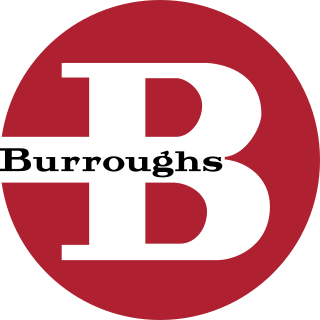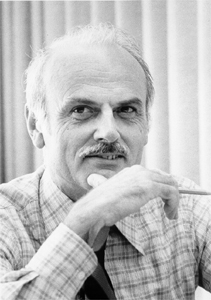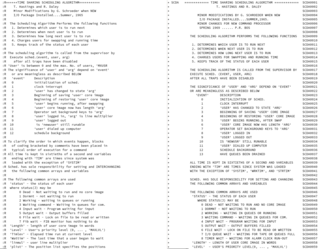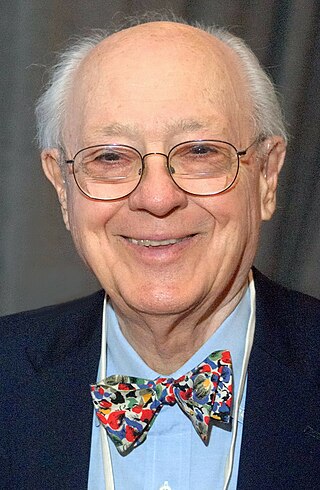Related Research Articles

The Burroughs Corporation was a major American manufacturer of business equipment. The company was founded in 1886 as the American Arithmometer Company by William Seward Burroughs. In 1986, it merged with Sperry UNIVAC to form Unisys. The company's history paralleled many of the major developments in computing. At its start, it produced mechanical adding machines, and later moved into programmable ledgers and then computers. It was one of the largest producers of mainframe computers in the world, also producing related equipment including typewriters and printers.

A minicomputer, or colloquially mini, is a type of smaller general-purpose computer developed in the mid-1960s and sold at a much lower price than mainframe and mid-size computers from IBM and its direct competitors. In a 1970 survey, The New York Times suggested a consensus definition of a minicomputer as a machine costing less than US$25,000, with an input-output device such as a teleprinter and at least four thousand words of memory, that is capable of running programs in a higher level language, such as Fortran or BASIC.

In computing, time-sharing is the concurrent sharing of a computing resource among many tasks or users by giving each task or user a small slice of processing time. This quick switch between tasks or users gives the illusion of simultaneous execution. It enables multi-tasking by a single user or enables multiple-user sessions.
Control Data Corporation (CDC) was a mainframe and supercomputer company that in the 1960s was one of the nine major U.S. computer companies, which group included IBM, the Burroughs Corporation, and the Digital Equipment Corporation (DEC), the NCR Corporation (NCR), General Electric, and Honeywell, RCA and UNIVAC. For most of the 1960s, the strength of CDC was the work of the electrical engineer Seymour Cray who developed a series of fast computers, then considered the fastest computing machines in the world; in the 1970s, Cray left the Control Data Corporation and founded Cray Research (CRI) to design and make supercomputers. In 1988, after much financial loss, the Control Data Corporation began withdrawing from making computers and sold the affiliated companies of CDC; in 1992, Cray established Control Data Systems, Inc. The remaining affiliate companies of CDC currently do business as the software company Dayforce.

Edgar Frank "Ted" Codd was an English computer scientist who, while working for IBM, invented the relational model for database management, the theoretical basis for relational databases and relational database management systems. He made other valuable contributions to computer science, but the relational model, a very influential general theory of data management, remains his most mentioned, analyzed and celebrated achievement.

The Compatible Time-Sharing System (CTSS) was the first general purpose time-sharing operating system. Compatible Time Sharing referred to time sharing which was compatible with batch processing; it could offer both time sharing and batch processing concurrently.

Charles William Bachman III was an American computer scientist, who spent his entire career as an industrial researcher, developer, and manager rather than in academia. He was particularly known for his work in the early development of database management systems. His techniques of layered architecture include his namesake Bachman diagrams.
CODASYL, the Conference/Committee on Data Systems Languages, was a consortium formed in 1959 to guide the development of a standard programming language that could be used on many computers. This effort led to the development of the programming language COBOL, the CODASYL Data Model, and other technical standards.
Electronic data processing (EDP) or business information processing can refer to the use of automated methods to process commercial data. Typically, this uses relatively simple, repetitive activities to process large volumes of similar information. For example: stock updates applied to an inventory, banking transactions applied to account and customer master files, booking and ticketing transactions to an airline's reservation system, billing for utility services. The modifier "electronic" or "automatic" was used with "data processing" (DP), especially c. 1960, to distinguish human clerical data processing from that done by computer.

International Computers Limited (ICL) was a British computer hardware, computer software and computer services company that operated from 1968 until 2002. It was formed through a merger of International Computers and Tabulators (ICT), English Electric Computers (EEC) and Elliott Automation in 1968. The company's most successful product line was the ICL 2900 Series range of mainframe computers.

Starting at the end of the nineteenth century, well before the advent of electronic computers, data processing was performed using electromechanical machines collectively referred to as unit record equipment, electric accounting machines (EAM) or tabulating machines. Unit record machines came to be as ubiquitous in industry and government in the first two-thirds of the twentieth century as computers became in the last third. They allowed large volume, sophisticated data-processing tasks to be accomplished before electronic computers were invented and while they were still in their infancy. This data processing was accomplished by processing punched cards through various unit record machines in a carefully choreographed progression. This progression, or flow, from machine to machine was often planned and documented with detailed flowcharts that used standardized symbols for documents and the various machine functions. All but the earliest machines had high-speed mechanical feeders to process cards at rates from around 100 to 2,000 per minute, sensing punched holes with mechanical, electrical, or, later, optical sensors. The operation of many machines was directed by the use of a removable plugboard, control panel, or connection box. Initially all machines were manual or electromechanical. The first use of an electronic component was in 1937 when a photocell was used in a Social Security bill-feed machine. Electronic components were used on other machines beginning in the late 1940s.

The Rochester Technology Campus is a facility shared by several companies in Rochester, Minnesota. The initial structure was designed by Eero Saarinen, who clad the structure in blue panels of varying hues after being inspired by the Minnesota sky and the nickname of the first occupant, Big Blue.
System Development Corporation (SDC) was a computer software company based in Santa Monica, California. Founded in 1955, it is considered the first company of its kind.

The Digital Equipment Computer Users' Society (DECUS) was an independent computer user group related to Digital Equipment Corporation (DEC). The Connect User Group Community, formed from the consolidation in May, 2008 of DECUS, Encompass, HP-Interex, and ITUG is the Hewlett-Packard’s largest user community, representing more than 50,000 participants.
SHARE Inc. is a volunteer-run user group for IBM mainframe computers that was founded in 1955 by Los Angeles-area users of the IBM 704 computer system. It evolved into a forum for exchanging technical information about programming languages, operating systems, database systems, and user experiences for enterprise users of small, medium, and large-scale IBM computers such as IBM S/360, IBM S/370, zSeries, pSeries, and xSeries. Despite the capitalization of all letters in the name, the official website says "SHARE is not an acronym; it's what we do."
National CSS, Inc. (NCSS) was a time-sharing firm in the 1960–80s, until its acquisition by Dun & Bradstreet in 1979. NCSS was originally headquartered in Norwalk, Connecticut, but relocated to Wilton in 1978. Sales offices, data centers, and development facilities were located at various sites throughout the U.S. Some additional sales offices were active in the UK and elsewhere.
International Business Machines (IBM) is a multinational corporation specializing in computer technology and information technology consulting. Headquartered in Armonk, New York, the company originated from the amalgamation of various enterprises dedicated to automating routine business transactions, notably pioneering punched card-based data tabulating machines and time clocks. In 1911, these entities were unified under the umbrella of the Computing-Tabulating-Recording Company (CTR).

Applied Data Research, Inc. (ADR), was a large software vendor from the 1960s until the mid-1980s. ADR is often described as "the first independent software vendor".
Gideon Isaiah Gartner was an American businessman, investor, and philanthropist. He was often referred to as the father of the modern analyst industry. He is best known as the founder of Gartner, Inc. a Stamford, Connecticut information technology (IT) research and advisory company.

The Association of Information Technology Professionals (AITP) is a professional association that focuses on information technology education for business professionals. The group is a non-profit US-oriented group, but its activities are performed by 62 local chapters organized on a geographic basis, and 286 student chapters at colleges and universities.
References
- ↑ Norberg, Arthur L. "Recent Monograph Publications and Research in CBI Collections" (PDF). Newsletter v.27 no.1. Charles Babbage Institute. Retrieved May 22, 2013.
- 1 2 "IBM User Groups in Europe" . Retrieved May 23, 2013.
- ↑ Panepinto, Joe (Jan 29, 1990). "Users groups gain ground by bending Big Blue's ear". Network World. Retrieved June 13, 2018.
- ↑ LaPlante, Alice (Nov 24, 1986). "IBM User Group is World's Most Influential". Infoworld. Retrieved June 13, 2018.
- ↑ Guide Intern. Corp. v. United States, 948F. 2d360 (7th Cir.1991). Brief of Appellant at 3.